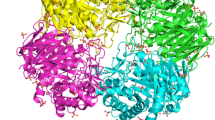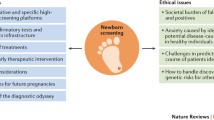Opinion statement
-
•Lysosomal storage disorders (LSDs), over 40 different diseases, are now considered treatable disorders. Only a few short years ago, Lysosomal storage disorders were seen as interesting neurodegenerative disorders without any potential for treatment. Effective treatment strategies such as bone marrow transplantation (BMT), enzyme replacement therapy (ERT), and glycolipid synthesis inhibition have been developed in the last 20 years and continue to be researched and evaluated.
-
•Bone marrow transplantation began approximately 15 years ago and has shown benefit for some of the lysosomal storage disorders. In order to be effective, the transplant must be performed early in the course of the disease, before the development of irreversible neurologic damage. Diseases such as Hurler appear to respond to BMT, however, improvement in bone disease is much less vigorous than responses in other organs. Krabbe disease responds if the transplant is performed before irreversible signs of neurologic damage appear. Metachromatic leukodystrophy may respond if the transplant can be performed early enough although peripheral nerve findings appear to progress. Other diseases, eg, GM1- and GM2-gangliosidoses do not appear to be altered by BMT.
-
•Despite its high cost, ERT has been very effective treatment for type I (non-neuronopathic) Gaucher disease. Enzyme replacement therapy for other LSDs, including ERT for Fabry and Pompe diseases, which are planned to be imminently introduced, and other enzymes such as for Morquio and Hunter diseases that are in the study phases, may be marketed in the very near future.
-
•Glycolipid inhibitors, such as N-butyldeoxynijirimycin (OGS-918), have been effective in reducing the liver and spleen volume in type I Gaucher disease. These oral inhibitors may prove to be important adjuncts to ERT and provide the advantage of being able to cross the blood/brain barrier, which limits enzyme access to brain. Currently, clinical studies are being conducted on patients with type III Gaucher disease and Fabry disease using OGS-918. Other, potentially more specific, glycolipid inhibitors are being developed.
Similar content being viewed by others
References
Poorthuis BJ, Wevers RA, Kleijer WJ, et al.: The frequency of lysosomal storage diseases in The Netherlands. Hum Genet 1999, 105:151–156.
Barton NW, Brady RO, Dambrosia JM, et al.: Replacement therapy for inherited enzyme deficiency—macrophage-targeted glucocerebrosidase for Gaucher’s disease. N Engl J Med 1991, 324:1464–1470.
Altarescu G, Schiffmann R, Parker CC, et al.: Comparative efficacy of dose regimens in enzyme replacement therapy of type I Gaucher disease. Blood Cells Mol Dis 2000, 26:285–290. Excellent recent article on enzyme replacement therapy.
Schiffmann R, Murray GJ, Treco D, et al.: Infusion of alpha-galactosidase A reduces tissue globotriaosylceramide storage in patients with Fabry disease. Proc Natl Acad Sci U S A 2000, 97:365–70. This is the first paper that discusses enzyme replacement therapy in Fabry disease.
Eng CM, Cochat P, Wilcox WR, et al.: Enzyme replacement in Fabry disease: results of a placebo-controlled phase 3 trial. Amer J Hum Genet 2000, 67(suppl 2):S38.
Cox T, Lachmann R, Hollak C, et al.: Novel oral treatment of Gaucher’s disease with N-butyldeoxynojirimycin (OGT 918) to decrease substrate biosynthesis. Lancet 2000, 355:1481–1485. This is the first human study that uses a glcolipid synthesis inhibitor.
Krivit W, Sung JH, Shapiro EG, Lockman LA: Microglia: the effector cell for reconstitution of the central nervous system following bone marrow transplantation for lysosomal and peroxisomal storage diseases. Cell Transplant 1995, 4:385–392.
Vellodi A, Young EP, Cooper A, et al.: Bone marrow transplantation for mucopolysaccharidosis type I: experience of two British centers. Arch Dis Child 1997, 76:92–99.
Peters C, Shapiro EG, Anderson J, et al.: Hurler syndrome II. Outcome of HLA-genotypically identical sibling and HLA-haploidentical related donor bone marrow transplantation in fifty-four children. The Storage Disease Collaborative Study Group. Blood 1998, 91:2601–2608. Large, multicenter review that gives a broader perspective on the effectiveness of bone marrow transplantation.
Guffon N, Souillet G, Maire I, et al.: Follow-up of nine patients with Hurler syndrome after bone marrow transplantation. J Pediatr 1998, 133:119–125.
Vellodi A, Young E, Cooper A, et al.: Long-term follow-up following bone marrow transplantation for Hunter disease. J Inherit Metab Dis 1999, 22:638–648.
Hoogerbrugge PM, Brouwer OF, Bordigoni P, et al.: Allogeneic bone marrow transplantaion for lysosomal storage diseases. Lancet 1995, 345:1398–1402.
Sivakumur P, Wraith JE: Bone marrow transplantation in mucopolysaccharidosis type IIIA: a comparison of an early treated patient with his untreated sibling. J Inherit Metab Dis 1999, 22:849–850.
Vellodi A, Young E, New M, et al.: Bone marrow transplantation for Sanfilippo disease type B. J Inherit Metab Dis 1992, 15:911–918.
Shapiro EG, Lockman LA, Balthazor M, Krivit W: Neuropsychological outcomes of several storage diseases with and without bone marrow transplantation. J Inherit Metab Dis 1995, 18:413–429.
Lee V, Li CK, Shing MM, Chik KW, et al.: Umbilical cord blood transplantation for Maroteaux-Lamy syndrome mucopolysaccharidosis type VII. Bone Marrow Transplant 2000, 26:455–458.
Herskhovitz E, Young E, Rainer J, et al.: Bone marrow transplantation for Maroteaux-Lamy syndrome (MPS VI): long-term follow-up. J Inherit Metab Dis 1999, 22:50–62.
Yamada Y, Kato K, Sukegawa K, et al.: Treatment of MPS VII (Sly disease) by allogeneic BMT in a female with homozygous A619V mutation. Bone Marrow Transplant 1998, 21:629–634.
Krivit W, Shapiro EG, Peters C, et al.: Hematopoietic stem-cell transplantation in globoid-cell leukodystrophy. N Engl J Med 1998, 338:1119–1126. This paper provides the first well documented evidence of bone marrow transplantation in Krabbe.
Malm G, Ringden O, Winiarski J, et al.: Clinical outcome in four children with metachromatic leukodystrophy treated by bone marrow transplantation. Bone Marrow Transplant 1996, 17:1003–1008.
Yeager AM, Uhas KA, Coles CD, et al.: Bone marrow transplantation for infantile ceramidase deficiency (Farber disease) [In Process citation]. Bone Marrow Transplant 2000, 26:357–363.
Bayever E, Kamani N, Ferreira P, et al.: Bone marrow transplantation for Niemann-Pick type IA disease. J Inherit Metab Dis 1992, 15:919–928.
Vellodi A, Hobbs JR, O’Donnell NM, et al.: Treatment of Niemann-Pick disease type B by allogeneic bone marrow transplantation. Br Med J 1987, 295:1375–1376.
Hsu YS, Hwu WL, Huang SF, et al.: Niemann-Pick disease type C (a cellular cholesterol lipidosis) treated by bone marrow transplantation. Bone Marrow Transplant 1999, 24:103–107.
Will A, Cooper A, Hatton C, et al.: Bone marrow transplantation in the treatment of alpha-mannosidosis. Arch Dis Child 1987, 62:1044–1049.
Wall DA, Grange DK, Goulding P, et al.: Bone marrow transplantation for the treatment of alpha-mannosidosis. J Pediatr 1998, 133:282–285.
Vellodi A, Cragg H, Winchester B, et al.: Allogeneic bone marrow transplantation for fucosidosis. Bone Marrow Transplant 1995, 15:153–158.
Taylor RM, Farrow BR, Stewart GJ: Amelioration of clinical disease following bone marrow transplantation in fucosidase-deficient dogs. Am J Med Genet 1992, 42:628–632.
Skorupa AF, Fisher KJ, Wilson JM, et al.: Sustained production of beta-glucuronidase from localized sites after AAV vector gene transfer results in widespread distribution of enzyme and reversal of lysosomal storage lesions in a large volume of brain in mucopolysaccharidosis VII mice. Exp Neurol 1999, 160:17–27.
Ohashi T, Yokoo T, Iizuka S, et al.: Reduction of lysosomal storage in murine mucopolysaccharidosis type VII by transplantation of normal and genetically modified macrophages. Blood 2000, 95:3631–3633.
Author information
Authors and Affiliations
Rights and permissions
About this article
Cite this article
Kaye, E.M. Lysosomal storage diseases. Curr Treat Options Neurol 3, 249–256 (2001). https://doi.org/10.1007/s11940-001-0006-9
Issue Date:
DOI: https://doi.org/10.1007/s11940-001-0006-9




